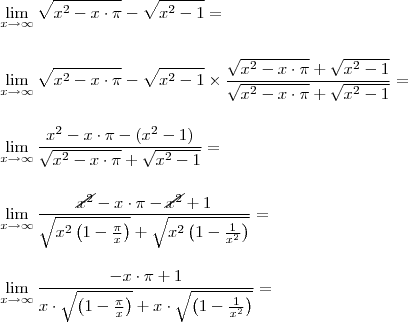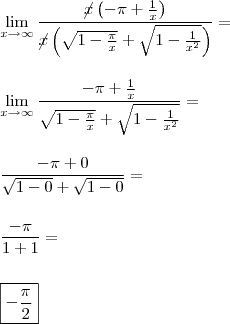 por Subnik » Sex Abr 03, 2015 19:43
por Subnik » Sex Abr 03, 2015 19:43
Calcule o limite:
![\lim_{x\rightarrow+/-\infty}\sqrt[]{x^2-x.\Pi}-\sqrt[]{x^2-1} \lim_{x\rightarrow+/-\infty}\sqrt[]{x^2-x.\Pi}-\sqrt[]{x^2-1}](/latexrender/pictures/8c7f1500438fe60757fb897c9e5fe62f.png)
Resposta:

-
Subnik
- Novo Usuário

-
- Mensagens: 2
- Registrado em: Sex Abr 03, 2015 19:31
- Formação Escolar: GRADUAÇÃO
- Andamento: cursando
 por adauto martins » Sáb Abr 04, 2015 12:14
por adauto martins » Sáb Abr 04, 2015 12:14
-
adauto martins
- Colaborador Voluntário

-
- Mensagens: 1171
- Registrado em: Sex Set 05, 2014 19:37
- Formação Escolar: EJA
- Área/Curso: matematica
- Andamento: cursando
 por DanielFerreira » Sáb Abr 04, 2015 12:23
por DanielFerreira » Sáb Abr 04, 2015 12:23
Olá
Subnik,
seja bem-vindo!


"Sabedoria é saber o que fazer;
habilidade é saber como fazer;
virtude é fazer."
(David S. Jordan)
--------------------------------------------------------------------------------
-
DanielFerreira
- Colaborador - em formação

-
- Mensagens: 1732
- Registrado em: Qui Jul 23, 2009 21:34
- Localização: Mangaratiba - RJ
- Formação Escolar: GRADUAÇÃO
- Área/Curso: Licenciatura em Matemática - IFRJ
- Andamento: formado
-
Voltar para Cálculo: Limites, Derivadas e Integrais
Se chegou até aqui, provavelmente tenha interesse pelos tópicos relacionados abaixo.
Aproveite a leitura. Bons estudos!
-
- [limites] reciso de ajuda nessa questão de limites raiz quad
por alexia » Ter Nov 15, 2011 19:55
- 1 Respostas
- 5003 Exibições
- Última mensagem por LuizAquino

Qua Nov 16, 2011 15:16
Cálculo: Limites, Derivadas e Integrais
-
- [Limites]Preciso de ajuda para calcular alguns limites
por Pessoa Estranha » Ter Jul 16, 2013 17:15
- 2 Respostas
- 4323 Exibições
- Última mensagem por LuizAquino

Qua Jul 17, 2013 09:12
Cálculo: Limites, Derivadas e Integrais
-
- [Limites] Ajuda com limites no infinito e continuidade
 por umbrorz » Dom Abr 15, 2012 00:54
por umbrorz » Dom Abr 15, 2012 00:54
- 3 Respostas
- 4575 Exibições
- Última mensagem por umbrorz

Seg Abr 16, 2012 11:46
Cálculo: Limites, Derivadas e Integrais
-
- [limites] exercicio de calculo envolvendo limites
por lucasdemirand » Qua Jul 10, 2013 00:45
- 1 Respostas
- 4081 Exibições
- Última mensagem por e8group

Sáb Jul 20, 2013 13:08
Cálculo: Limites, Derivadas e Integrais
-
- [Limites] Dúvida sobre limites laterais
por Subnik » Sáb Abr 04, 2015 18:24
- 1 Respostas
- 2660 Exibições
- Última mensagem por DanielFerreira

Dom Abr 12, 2015 16:10
Cálculo: Limites, Derivadas e Integrais
Usuários navegando neste fórum: Nenhum usuário registrado e 2 visitantes
Assunto:
Unesp - 95 Números Complexos
Autor:
Alucard014 - Dom Ago 01, 2010 18:22
(UNESP - 95) Seja L o Afixo de um Número complexo

em um sistema de coordenadas cartesianas xOy. Determine o número complexo b , de módulo igual a 1 , cujo afixo M pertence ao quarto quadrante e é tal que o ângulo LÔM é reto.
Assunto:
Unesp - 95 Números Complexos
Autor:
MarceloFantini - Qui Ago 05, 2010 17:27
Seja

o ângulo entre o eixo horizontal e o afixo

. O triângulo é retângulo com catetos

e

, tal que

. Seja

o ângulo complementar. Então

. Como

, o ângulo que o afixo

formará com a horizontal será

, mas negativo pois tem de ser no quarto quadrante. Se

, então

. Como módulo é um:

.
Logo, o afixo é

.
Powered by phpBB © phpBB Group.
phpBB Mobile / SEO by Artodia.
![\lim_{x\rightarrow+/-\infty}\sqrt[]{x^2-x.\Pi}-\sqrt[]{x^2-1} \lim_{x\rightarrow+/-\infty}\sqrt[]{x^2-x.\Pi}-\sqrt[]{x^2-1}](/latexrender/pictures/8c7f1500438fe60757fb897c9e5fe62f.png)


![L=\lim_{x\rightarrow \infty}{x}^{2}(\sqrt[]{1-\pi/x}-\sqrt[]{1-1/{x}^{2}}) L=\lim_{x\rightarrow \infty}{x}^{2}(\sqrt[]{1-\pi/x}-\sqrt[]{1-1/{x}^{2}})](/latexrender/pictures/6731087004ef601ee06aa0819ec44cad.png) =
=![\lim_{x\rightarrow \infty}{x}^{2}(\sqrt[]{1-\pi/x}-\sqrt[]{1-1/{x}^{2}}).(\sqrt[]{1-\pi/x}+\sqrt[]{1-1/{x}^{2}}/(\sqrt[]{1+\pi/x}+\sqrt[]{1-1/{x}^{2}}) \lim_{x\rightarrow \infty}{x}^{2}(\sqrt[]{1-\pi/x}-\sqrt[]{1-1/{x}^{2}}).(\sqrt[]{1-\pi/x}+\sqrt[]{1-1/{x}^{2}}/(\sqrt[]{1+\pi/x}+\sqrt[]{1-1/{x}^{2}})](/latexrender/pictures/6cc1cb3adfadb2ae957e11b9c15a652e.png) =
=![\lim_{x\rightarrow \infty}{x}^{2}(1-\pi/x-1-1/{x}^{2})/\sqrt[]{1-\pi/x}+\sqrt[]{1-1/{x}^{2}})=\lim_{x\rightarrow \infty}-(\pi.x+1)/(\sqrt[]{1-\pi/x}+\sqrt[]{1-1/{x}^{2}})= \lim_{x\rightarrow \infty}{x}^{2}(1-\pi/x-1-1/{x}^{2})/\sqrt[]{1-\pi/x}+\sqrt[]{1-1/{x}^{2}})=\lim_{x\rightarrow \infty}-(\pi.x+1)/(\sqrt[]{1-\pi/x}+\sqrt[]{1-1/{x}^{2}})=](/latexrender/pictures/e943b2e95b004ffee6cdb038673aa188.png) =
=![\lim_{x\rightarrow \infty}-( \pi x + 1)/\sqrt[]{1-\pi/x}+\sqrt[]{1-1/{x}^{2}}) \lim_{x\rightarrow \infty}-( \pi x + 1)/\sqrt[]{1-\pi/x}+\sqrt[]{1-1/{x}^{2}})](/latexrender/pictures/0a37057a51e6e4e6ea9a1c9c14da8f0a.png) =
=![\lim_{x\rightarrow \infty}-x(\pi+1/x)/(\sqrt[]{1-\pi/x}+\sqrt[]{1-1/{x}^{2}}) \lim_{x\rightarrow \infty}-x(\pi+1/x)/(\sqrt[]{1-\pi/x}+\sqrt[]{1-1/{x}^{2}})](/latexrender/pictures/69322c445ece8eaac302e7094ab5cafc.png) =
=![\lim_{x\rightarrow \infty}-(\pi+1/{x}^{2})/(\sqrt[]{1/{x}^{2}-\pi/{x}^{3}}+\sqrt[]{1-1/{x}^{4}}=-\pi/2 \lim_{x\rightarrow \infty}-(\pi+1/{x}^{2})/(\sqrt[]{1/{x}^{2}-\pi/{x}^{3}}+\sqrt[]{1-1/{x}^{4}}=-\pi/2](/latexrender/pictures/9c94fb37b733d5112afdb7f220e3fb78.png)




 em um sistema de coordenadas cartesianas xOy. Determine o número complexo b , de módulo igual a 1 , cujo afixo M pertence ao quarto quadrante e é tal que o ângulo LÔM é reto.
em um sistema de coordenadas cartesianas xOy. Determine o número complexo b , de módulo igual a 1 , cujo afixo M pertence ao quarto quadrante e é tal que o ângulo LÔM é reto. o ângulo entre o eixo horizontal e o afixo
o ângulo entre o eixo horizontal e o afixo  . O triângulo é retângulo com catetos
. O triângulo é retângulo com catetos  e
e  , tal que
, tal que  . Seja
. Seja  o ângulo complementar. Então
o ângulo complementar. Então  . Como
. Como  , o ângulo que o afixo
, o ângulo que o afixo  formará com a horizontal será
formará com a horizontal será  , mas negativo pois tem de ser no quarto quadrante. Se
, mas negativo pois tem de ser no quarto quadrante. Se  , então
, então  . Como módulo é um:
. Como módulo é um:  .
. .
.